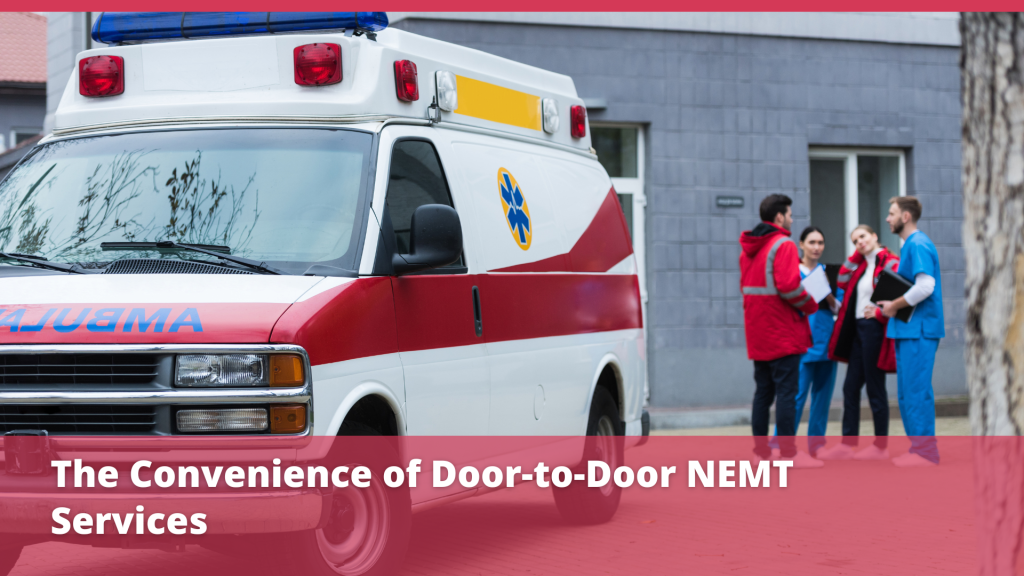New at Safr Care
The Convenience of Door-to-Door NEMT Services

The Convenience of Door-to-Door NEMT Services
For individuals with mobility challenges, accessing medical appointments can be a significant hurdle. Traditional transportation options often lack the necessary support and accessibility, making it difficult to maintain consistent healthcare. This is where door-to-door Non-Emergency Medical Transportation (NEMT) services shine, offering unparalleled convenience and peace of mind. This article explores the numerous benefits and advantages of door-to-door NEMT services.
Understanding Door-to-Door NEMT
Door-to-door NEMT services go beyond simple transportation. They provide comprehensive assistance from the moment a patient leaves their home until they arrive at their destination and back. This includes helping with boarding, disembarking, navigating medical facilities, and ensuring a safe and comfortable journey.
- Personalized Assistance: Tailored support based on individual needs.
- Reduced Stress: Eliminating the challenges of traditional transportation.
- Enhanced Independence: Enabling patients to maintain their autonomy.
1. Eliminating Transportation Barriers
One of the primary advantages of door-to-door NEMT is the elimination of transportation barriers. Individuals with mobility issues often face difficulties with public transportation, taxis, or even relying on family members.
- Accessibility: Vehicles equipped with ramps, lifts, and securement systems.
- Reliability: Scheduled pick-ups and drop-offs, ensuring timely arrival.
- Comfort: Specially designed vehicles to accommodate various medical needs.
2. Providing Peace of Mind
Knowing that reliable transportation is arranged can significantly reduce anxiety and stress. Door-to-door NEMT services offer peace of mind to both patients and their families.
- Professional Drivers: Trained and experienced in assisting patients with mobility challenges.
- Safety and Security: Ensuring patients are transported safely and securely.
- Real-Time Tracking: Providing updates on the vehicle’s location and arrival time.
3. Enhancing Healthcare Access
Door-to-door NEMT services play a crucial role in enhancing healthcare access for vulnerable populations. Consistent access to medical appointments leads to better health outcomes and improved quality of life.
- Timely Appointments: Reducing missed appointments and delays in treatment.
- Consistent Care: Ensuring patients receive regular medical attention.
- Improved Health Outcomes: Contributing to better management of chronic conditions.
4. Offering Personalized Support
Every patient has unique needs, and door-to-door NEMT services offer personalized support to accommodate these differences. This tailored approach ensures a comfortable and stress-free experience.
- Assistance with Mobility Devices: Handling wheelchairs, walkers, and other aids.
- Door-to-Door Assistance: Helping patients from their doorstep to the medical facility.
- Flexible Scheduling: Accommodating various appointment times and locations.
5. Fostering Independence and Dignity
Door-to-door NEMT services empower individuals to maintain their independence and dignity. By providing reliable and respectful transportation, these services help patients feel more in control of their lives.
- Autonomy: Enabling patients to manage their own transportation needs.
- Respectful Service: Treating patients with dignity and compassion.
- Reduced Reliance: Minimizing dependence on family members or caregivers.
Conclusion: The convenience of door-to-door NEMT services extends far beyond simple transportation. It provides essential support, enhances healthcare access, and fosters independence for individuals with mobility challenges. By eliminating transportation barriers and offering personalized assistance, these services play a crucial role in improving the quality of life for vulnerable populations.
